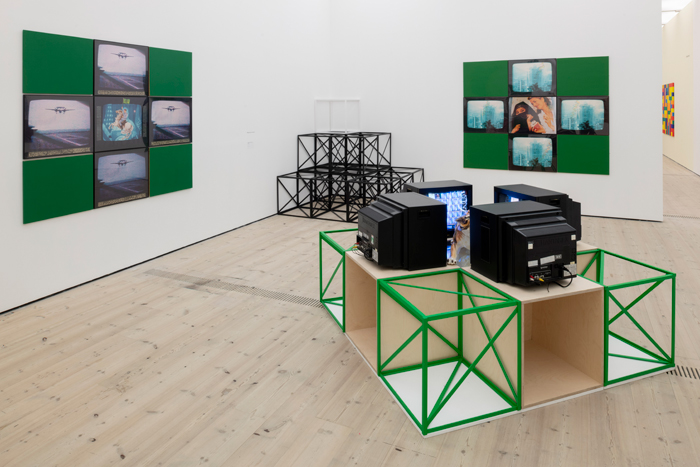“People are really rather afraid that this country might be rather swamped by people with a different culture.” These infamous words, spoken by Margaret Thatcher in 1978, seem strikingly current. They appear almost verbatim in Rasheed Araeen’s Look Mama… Macho! (1983–86), an arresting mixed-media piece comprising three large photographs intersected by geometric lattice reliefs. The Pakistani-born British artist, who is pictured gagged in its central panel and flanked by priapic goats, created the work to register his disgust at the attitudes towards immigrants and ethnic minorities in Britain. Its deployment of political and formalist concerns typifies Araeen’s approach to artmaking, the full spectrum of which is presented at the Baltic in what is, remarkably, the first comprehensive survey of the octogenarian’s 60-year career.
Opening the chronological show are the artist’s experiments as a young painter in Karachi during the 1950s and early 60s. It’s a motley collection in which formative landscapes and portraits give way to tentative forays into abstraction, yet even the earliest works display his hallmark concern with geometry and line. Packing a punch upstairs is a colourful selection of his better-known minimalist works, made after he arrived in London in 1964. Formed from interlocking lattice cubes and rectangles, these muscular structures evoke Sol LeWitt’s geometric vocabulary, though stem from Araeen’s background as a civil engineer and his encounters with Anthony Caro’s coloured metal sculptures. Particularly compelling is the optical buzz of BoO (1969), an orange-and-blue wood relief selected as a runner-up in the 1969 John Moores Painting Prize.

Despite this early success, Araeen found himself increasingly sidelined by the artworld establishment. Rejection coupled with experiences of racial prejudice led to his politicisation during the 1970s. Works from this period addressing racism and colonialism include the biting four-panel collage For Oluwale (1971–1973), dedicated to a Nigerian immigrant who was found drowned following systematic police harassment. Nearby, photographs show officers protecting the National Front in When they meet (1973), while the slideshow ‘Paki Bastard’ (Portrait of the Artist as a Black Person) (1977/2016) documents Araeen’s stirring 1977 performance where he was gagged, ostensibly attacked and left for dead. But without the artist’s presence, the power of the original is barely approached.
Araeen’s convictions regarding cultural imperialism led him in 1978 to found Black Phoenix as an outlet for his critical writings. Relaunched in 1987 as Third Text, the journal was soon leading the debate on postcolonialism and art. An entire room of back issues is presented here (The Reading Room, 2017), highlighting the importance of writing in Araeen’s expanded practice. Indeed, the scope of his activities is intriguing, pivoting on a conspicuous vacillation between aesthetic sensibilities and political consciousness. Occasionally the two meld elegantly, as in the lesser-known Cruciform series made between 1985 and 1996. These slick, nine-panel grids – incorporating photographs, Arabic texts and green monochromes – interrogate the economic, military and cultural hegemony of the West and its relationship with the Middle East. White Stallion (1987–91), which combines images of Saddam Hussein, ‘Stormin’ Norman Schwarzkopf and US aircraft, is a standout work. Conversely, the recent Opus paintings (2016–17) in which configurations of coloured diamonds attempt to reposition geometric abstraction as a product of medieval Islam, separate from modernist discourses, appear as second-rate Op art. Not that it really matters at this stage, for although Araeen has been subject to the blindness of Eurocentric institutions for decades, this considered exhibition offers a timely corrective, assuring his oeuvre takes its rightful place in a revised canon.
Rasheed Araeen: A Retrospective at Baltic Centre for Contemporary Art, Gateshead, 19 October – 27 January
From the December 2018 issue of ArtReview
